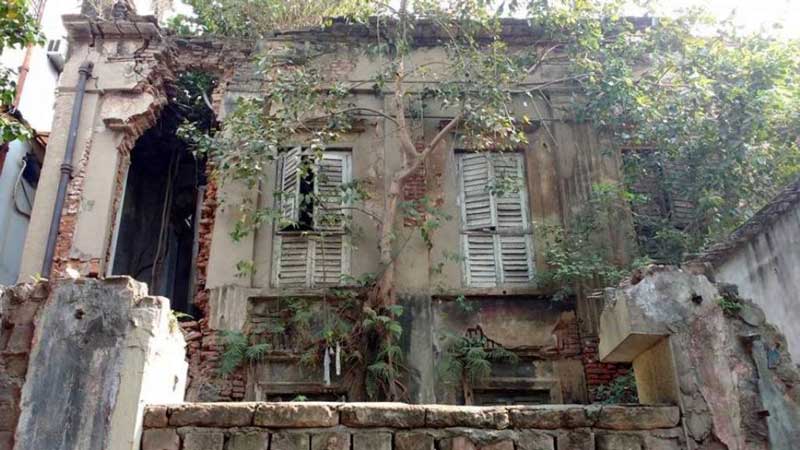
Calcutta was all set to lose one of its heritage buildings unceremoniously. Formerly located at No 13, Cornwallis Street, now 13/1 Bidhan Saranac, right opposite the Sadharan Brahmo Samaj, the age-old structure with a glorious past and attached with the memories of many illustrious names, was being pulled down to make space for another faceless high rise or a trading-cum-entertaining centre in the city.
Originally, the building belonged to the famous Laha family, a prominent business family of Calcutta, who owned three other mansions in the vicinity. This particular building was known as ‘Laha Babuder Bari’ in the locality. It is said that they used to rent out this place to Sadharon Brahma Samaj for hosting important meetings and functions.
Radharaman Mitra, the recipient of Sahitya Akademi Award in 1981 for his book ‘Kolkata Darpan’ contemplated that Nabagopal Mitra, known as a poet, playwright, patriot and founder of the Hindu Mela, founded his ‘National School’ at 13, Cornwallis Street. Unfortunately, the school did not continue for long and merged with the Calcutta Training Academy of Thakurdas Chakraborty, which was also housed in the same building and finally shifted to 13, Shimla Street. However, 13 Cornwallis Street had briefly housed another school. Brahmo Balika Shikhshalaya, guided by the principles of the Brahmo Samaj Movement was established in the building on 16 May 1890. The school, a product of the Bengal Renaissance, was the result of the untiring efforts of Pandit Shivnath Shastri, Dwarakanath Gangopadhyay, Upendra Kishore Ray Chowdhury, Anandamohan Basu and others. However, in 1903 a plot of land along with a house was purchased on Upper Circular Road and the School shifted there.
Brahmo Balika Shikhshalaya was in fact the second school with which Dwarakanath Gangopadhyay was attached. Long before that, in1873, when a British Orientalist Annette Akroyd started the Hindu Mahila Vidyalaya, a boarding school at 22 Beniapukur Lane, Dwarkanath took the responsibility to serve the boarding school as the headmaster, teacher, guard and the maintenance man. Later, the school was renamed Banga Mahila Vidyalaya and was subsequently merged with Bethune School.

Born in 1845 in a village in Bikrampur, now in Bangladesh, Dwarkanath Gangopadhay started to publish a weekly magazine from his young age, named ‘Abalabandhab’ (Friend of Women) from Dhaka. According to American historian David Kopf, that was probably the first magazine in the world devoted solely to the liberation of women. He came to Calcutta in 1870 and within a short time, raised a storm within the Brahmo Samaj on the issue of women sitting behind the screen during the prayer meetings. Subsequently, after the split in the Samaj and the formation of the Sadharan Brahmo Samaj in 1878, Dwarkanath served several terms as the secretary of Sadharan Brahmo Samaj.
A few years after the death of his first wife, Dwarkanath married Kadambini Basu and settled at 13, Cornwallis Street. Kadambini was the first women graduate from the Calcutta University and Dwarkanath fought alongside Kadambini to secure her admission at the Calcutta Medical College. Eventually, they succeeded in their mission and Kadambini became one of the first women to receive a degree in medicine in India.
A few years after Dwarkanath shifted to 13 Cornwallis Street, his daughter from his first marriage, Bidhumukhi also settled on the first floor of the same building with her husband Upendra Kishore Ray Chowdhury. Thus, the building can be identified as the birthplace of Sukumar Ray, son of Upendra Kishore and father of the great filmmaker Satyajit Ray.
According to the eminent writer Leela Mazumder, her illustrious cousin brother Sukumar Ray was born in a large building, opposite the Sadharon Brahmo Samaj, locally known as 'Lahababuder Bari'. She also mentioned that, except Subimal, all the siblings of Upendra Kishore were born at 13, Cornwallis Street. This means, Sukumar Ray, Sukhalata Rao, Subinoy Ray, Punyalata Chakraborty, and Shantilata Chowdhury - all the illustrators brothers and sisters were growing up and flourished around 'Sandesh', the periodical founded by their father Upendra Kishore Ray Chowdhury in that historic building located at 13 Cornwallis Street.
Today, the grand old historic building at 13 Cornwallis Street, now13/1 Bidhan Sarani, which has witnessed lots of social and political changes of Calcutta, is counting its days. The locals are apprehensive that the ancient heritage structure with large columns, shuttered windows, iron grilles, long verandahs with lattice would soon be erased from the face of the city. However, there is a silver line. Followed by a stay order, the progress of demolition has been stopped for the time being. It is said that the plan for the proposed new building is yet to be sanctioned by the authority and the old building is to be examined by the experts, before taking any further action to demolish it.
